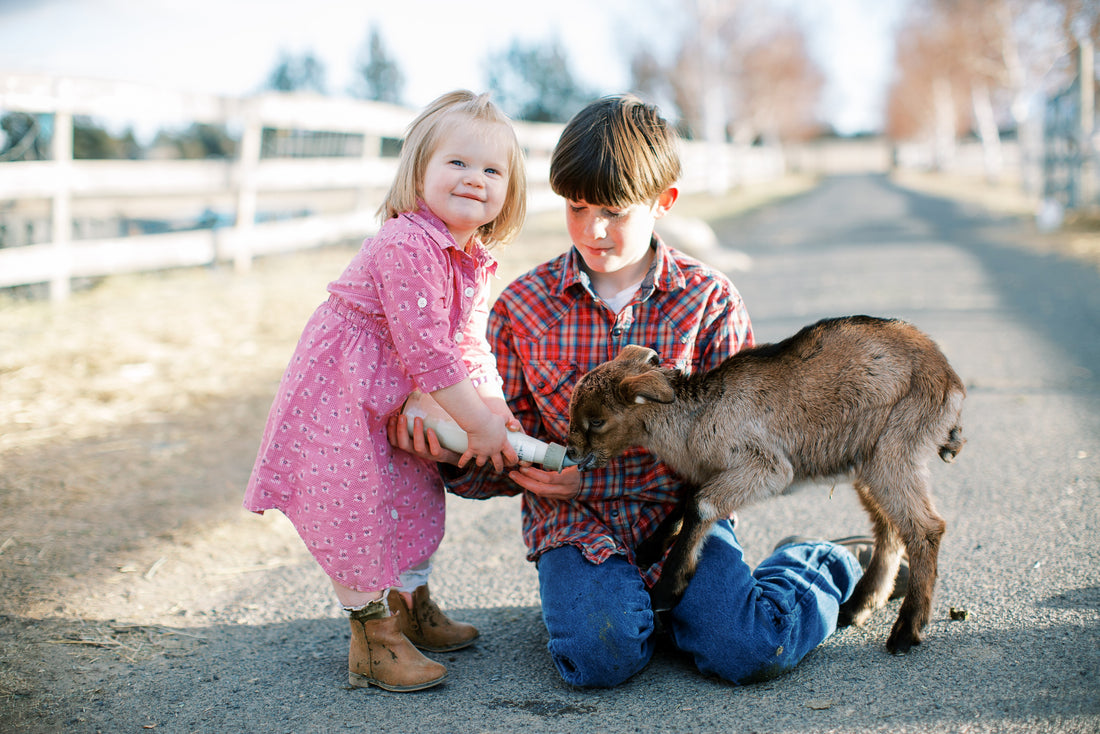Raising milk goats is quite an exciting adventure that’s both rewarding and fulfilling. Bend Soap Company founders, Dwight and Marilee, along with their entire crew, started raising goats in 2007. While the herd has since been moved to our sister farm across town and are under the care of new farmers, the Johnson’s have a plethora of goat raising experience under their belts. We’ve asked them to share their goat knowledge and all the tips they’ve picked up over the years on how to raise a healthy herd of dairy goats.
This blog post was written by Bend Soap Company Founders, Dwight and Marilee Johnson.
Goat milk? More like liquid gold
Raising dairy goats is such a beautiful way to provide fresh, great-tasting milk for your family. Goat milk is beyond delicious and we often refer to it as “liquid gold” because of its superior nourishment. Goat milk is naturally homogenized meaning that the cream does not separate from the rest of the milk other than a bit of rich white cream that might collect at the top. The milk has small fat molecules, making it easily digestible for most humans.
🛈 Fun fact: The cream in fresh goat milk does not separate like most other milks!
Goat milk is also high in nutrients like vitamin A. While vitamin A is found in many plant-based forms like fruits and vegetables, the rich, fat-soluble vitamin A you get from goat milk is especially helpful in creating strong bones and building a healthy immune system.
🛈 Fun fact: Goat milk is consumed more than cow's milk worldwide.
In a general sense, the U.S. seems to prefer cows milk over goats milk. But in most cultures worldwide, goat milk is the more common staple. Goat milk tends to be more gentle on the stomach and therefore is more easily digestible in the body. Its composition is similar to that of human breast milk.

🛈 Fun fact: Even if you’re allergic to cow milk, you may be able to tolerate goat milk.
Picking Your Goat Breed
There are several different breeds of dairy goats including our favorites, the Nubians. While they may not be the highest milk producers of all dairy goats, we think they have the best flavor and produce milk that’s especially high in creamy butter fat.
Here’s a short list of goat breeds:
- Nubian: An English breed mixed with a breed from India.
- LaMancha: An American breed with short, almost undetectable ears.
- Pygmy: A dwarf breed that’s not too much of a milk producer.
- Alpine: A French breed with high milk production yields.
- Saanen: A Swiss breed with highest milk production and largest size.
- Toggenburg: Another Swiss breed.
- Oberhasli: An Alpine breed with uniquebrown coloring.
Today, as Bend Soap Company has grown and our uses for fresh goat milk have expanded, we’ve added many more goats to our herd. We now have a mix of Nubian, Saanen, Alpine, and LaMancha goats.
🛈 Fun fact: Certain breeds of goats have two dangling tassels on their neck known as “waddles”.
The Commitment with Dairy Goats
Choosing to raise dairy goats means that you’ll be committing to milking goats regularly, so get ready for the new rhythm of dairy life!
Typically, a dairy goat will be milked both morning and evening for about 8-10 months out of the year. For some months, the doe might have kids (baby goats under a year of age) attached and won’t have any extra milk to give. During those months, careful attention must be given to their diet and care. For approximately two months out of each year, the doe is “dry” meaning that she no longer produces milk so that she can care for the baby goat developing in utero.
🛈 Fun fact: Some mature goats can produce so much milk that they can give almost a gallon in each milking session.
Spacing the milking 12 hours apart is ideal for the best production. You would think that early rising and getting it done first thing is the way to go, but our family found that milking at 8:30am and 8:30pm worked best for our schedule. That way, if we had evening plans, coming home by 8:30 didn’t seem too bad in comparison to 6:30pm or 7pm.
The yearly cycle for a dairy goat is as follows:
- Spring: This is the kidding season when new baby goats are born and the does are “freshened” with milk.
- Weaning: Goat kids will nurse off their mama does for several weeks before being weaned. At this point, the does still produce enough milk to be milked twice a day!
- Fall: It’s breeding season! The does are bred in order to “freshen” again in the spring, but we keep milking twice per day.
- Drying Up: The does stop producing milk to focus on the development of baby goats in utero.
- Spring: Back to another season of kidding and freshening again.
Freshening
A fresh supply of milk starts to be produced by a female doe when she gives birth, starting with a rich and nourishing milk called colostrum.
🛈 Fun fact: “Freshening” is a term used to describe each time a goat gives birth and is thus “in the milk.”
Colostrum is the kids’ first milk and is necessary for producing a healthy immune system. The doe passes along a lot of nourishment in the colostrum. If a doe is a little older and has had many kids, she might have an abundance of colostrum and, in this case, it's helpful to collect some to freeze. When a goat is sick, giving some warmed colostrum can be a first line of defense.
Does typically cannot produce milk unless they are first bred, and then deliver a goat kid (or two or more). I say “typically” because there are those rare instances where a goat begins to give milk even though it had never kidded. It’s rare and odd. But for the rest of the goats, delivering kids brings on fresh milk.
🛈 Fun fact: A mama goat will give birth every year!
The milk supply for a goat might last over a year, but by that time, the milk supply could be very low. For best production — and the health of the doe — a dairy goat is bred each year. When the supply wanes in the fall, the goat is bred, and within three months she becomes “dry.”

Kidding
Kidding season — when there are brand new baby goats everywhere — is one of our favorite times of the year! Mama goats will typically deliver twins - having just one single kid is less common than having two. Triplets are also common and in some scenarios, four or more goats are born. In all our years of raising goats, we’ve only had 1 set of “quads.”
🛈 Fun fact: A doe that has twins each year could have over 24 kids in its lifetime! Sometimes even more.
Doelings are baby girl kids and bucklings are baby boy kids. While most kids naturally learn how to nurse off the doe, they’ll occasionally need some assistance or have to be bottle fed if they don’t bond with the mother. Bottle feeding baby goats creates a very special bond between you and the kid. The kid will come bounding up to you when it sees you and often suck on your finger.
🛈 Fun fact: A baby goat will stand up within the first few hours of being born!
The Basics: food & water
To take care of your herd, you’ll need to have a decent-sized, fully-fenced area of land. A grassy pasture is preferred to allow the goats to graze, but if you’re bringing in their food, a small paddock can work as well. If there are trees in the field, you may want to determine ahead of time if the goats will be eating the bark or damaging the trees. Goats eat almost anything, which can be great or detrimental to your trees.
Goats are social, so having at least two goats is best and will help prevent the one from whining. Visiting and talking to your goats keeps them calm and happy.
🛈 Fun fact: Happy goats give the best tasting milk!
Inside your fenced area, you’ll need a place for fresh water. A standard “trough” works well, just keep it clean and fresh. If you live somewhere where winter frost and ice is a factor, finding an in-tank water heater is a must to ensure that the goats always have access to liquid (not frozen) water. You’ll need a power supply for this, but it will keep the water warm and drinkable all winter, without need for breaking ice.
What you feed your goats will often have a great influence on how the milk tastes. Weeds will flavor the milk in a bitter way. Hay or Alfalfa is an ideal feed for goats. Alfalfa tends to help goats produce more milk, but can also flavor the milk slightly. Having a raised “bin” for food is helpful in keeping waste low.
🛈 Fun fact: Goats that eat weeds will often have strange tasting milk.
Milking Supplies
In order to milk your goats, you’ll want to have a small gate that can be opened and closed to let one or two goats through at a time into a milking area. In your milking area, you’ll need a stanchion or “shelf” for the goats to hop up onto. This brings the goats udders up to a more easily accessible milking height. The stanchion should have a space for the goat’s head to reach through. A bucket of highly sought after grain should sit just beyond the space and when the goat reaches through, the head will be locked in loosely. We’ve learned that dairy goats LOVE their milking and grain time!

Grain is used to help a goat relax and let her milk come down. It’s also a great supplement, providing extra calories and nutrients that help produce premium milk. Be sure to keep your grain in an air-tight container to keep out pests and to keep the goats from busting into the grain and bloating.
A stainless steel bucket is your next must-have. Milk into a tall clean bucket, strain out any debris and store milk as quickly as possible in a clean jar in the fridge.
🛈 Fun fact: The faster you cool your milk, the better the flavor and the longer it lasts.
Back to You
Have you ever thought about raising your own dairy goats? Share your thoughts and inspire others in the comments below.





4 comments
It’s good to know that dairy goats are typically milked twice a day. I would really like to get some small dairy goats so I can try backyard farming. I have three acres of land, so I think I have enough space to raise them comfortably. https://nigeriandwarfgoatsva.com/
Is your family still working the farm? In the first part of this blog you stated that the farm was moved across town so that other farmers can run the farm? I would love to see some videos of the kids working the farm. Thank you for sharing, Pam
Hello, I love your soaps. I have been using them for years. I have one thing that struck me was what happens when they don’t produce anymore???? I am an animal lover!
Someday! I’d love to have milking goats💜